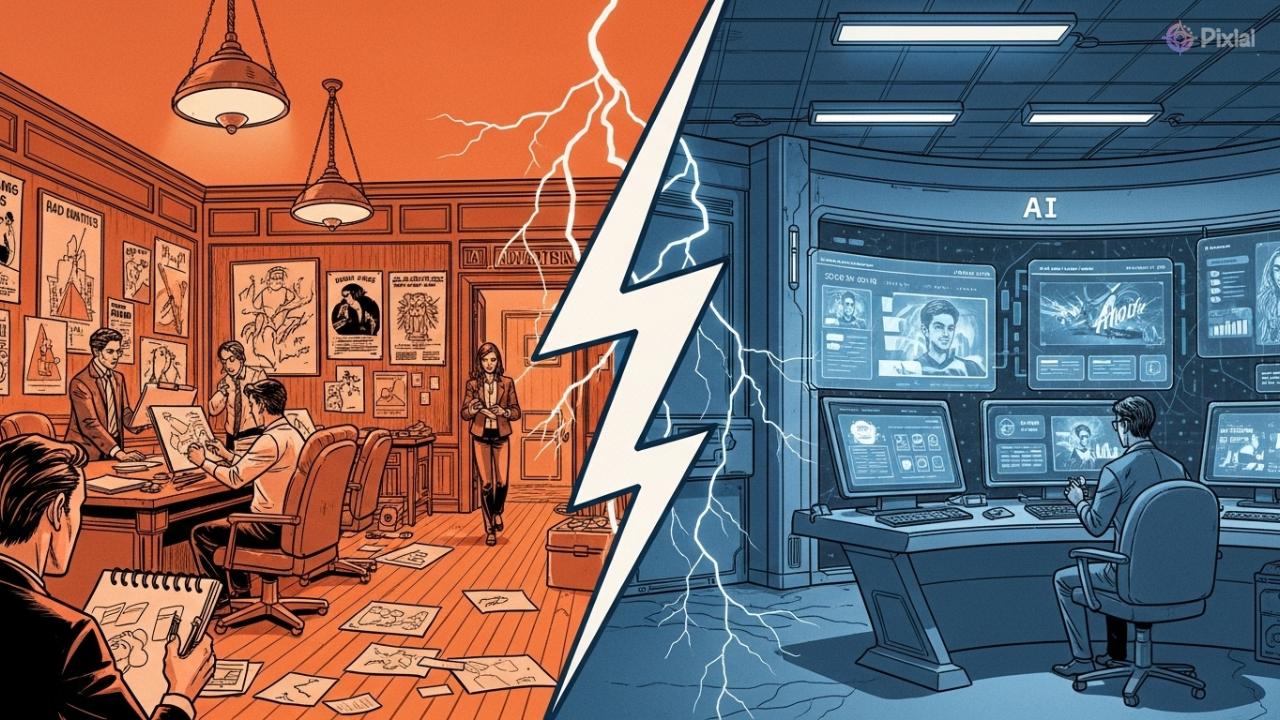By October 2025, a fierce debate rages in every marketing department: Is AI the death of creativity?
While headlines predict the end of the creative director, new data reveals a shocking twist!
Brands that masterfully blend AI with human intuition are seeing a 30% higher Return on Ad Spend (ROAS) than those who rely on either one alone.
The future isn’t human vs. machine; it’s a powerful, performance-driving collaboration.
Generative AI produces stunning visuals and copy in seconds. And it’s natural to question the value of slow, expensive human ideation.
But relying solely on AI-produced generic, soulless content fails to connect.
Relying solely on human creativity is inefficient and unscalable.
The truth is, AI is not a replacement for human creativity; it’s the ultimate co-pilot. It’s the data-driven engine that handles the repetitive, analytical heavy lifting, freeing human strategists to focus on:
- Building emotional narratives
- Understanding cultural nuance
- Crafting unforgettable brand stories.
It’s time to move beyond the fear and start building the future, a future facilitated by platforms like the Pixi AI Marketing Tools suite.
Table of Contents
| Sections | Key Findings |
| The Evolution of Advertising | AI automation is the answer to declining engagement and ad fatigue in traditional campaigns. |
| The Roles of AI and Humans | AI excels at data-driven tasks, while humans provide irreplaceable emotional storytelling and strategy. |
| Proven Hybrid Strategies | The best results come from using AI for analysis and letting humans direct the creative message. |
| Real-World Brand Examples | Global giants like Coca-Cola and Nike are already winning by blending AI tools with human art direction. |
| Tools and Frameworks | A structured workflow (Analyze → Ideate → Create → Optimize → Scale) is key to implementation. |
| The Future of Advertising | Brands that successfully merge human emotion with AI precision will dominate the market. |
The Evolution of Advertising: From Human Ideas to AI-Powered Campaigns
This hybrid approach is the new blueprint for success, and the brands that master it will emerge as leaders.
Why Traditional Ads No Longer Perform Like Before
For decades, the advertising formula was simple: a big idea, a big budget, and a big media buy. Today, that model is broken. Consumers are inundated with thousands of messages daily, leading to severe ad fatigue.
Recent 2025 data from Optimove shows that 70% of consumers have unsubscribed from brand communications in the last three months due to overwhelming message volume.
Engagement is plummeting because audiences crave relevance and novelty, not repetition.
A Smartly.io study confirms this, revealing that 84% of consumers find ads that rotate or update feel more relevant.
The one-size-fits-all creative campaign is officially dead.
The Rise of AI in Advertising and Creative Optimization
This is where AI entered the scene—not as a creative director, but as a hyper-efficient optimization engine.
Platforms like Google Performance Max and Meta’s Advantage+ have begun using machine learning to automate bidding, targeting, and the combination of ad components.
AI could analyze millions of data points in real-time to determine which headline worked best with which image for a specific audience segment.
This brought unprecedented efficiency, reducing CPCs and freeing up marketers from tedious manual adjustments.
Why Balancing Creativity and Automation is the New Success Formula
However, efficiency alone doesn’t build a brand!
Early AI-driven campaigns often felt generic and disjointed. They lacked a cohesive narrative and the emotional spark that turns a simple ad into a cultural moment.
The market quickly realized that automation without artistry is a race to the bottom.
So, the new success formula requires a delicate balance: leveraging AI for its speed, scale, and analytical power.
And relying on human creativity to provide the strategic vision, emotional depth, and brand soul that machines cannot replicate.
Understanding the Roles: What AI and Humans Each Bring to Advertising
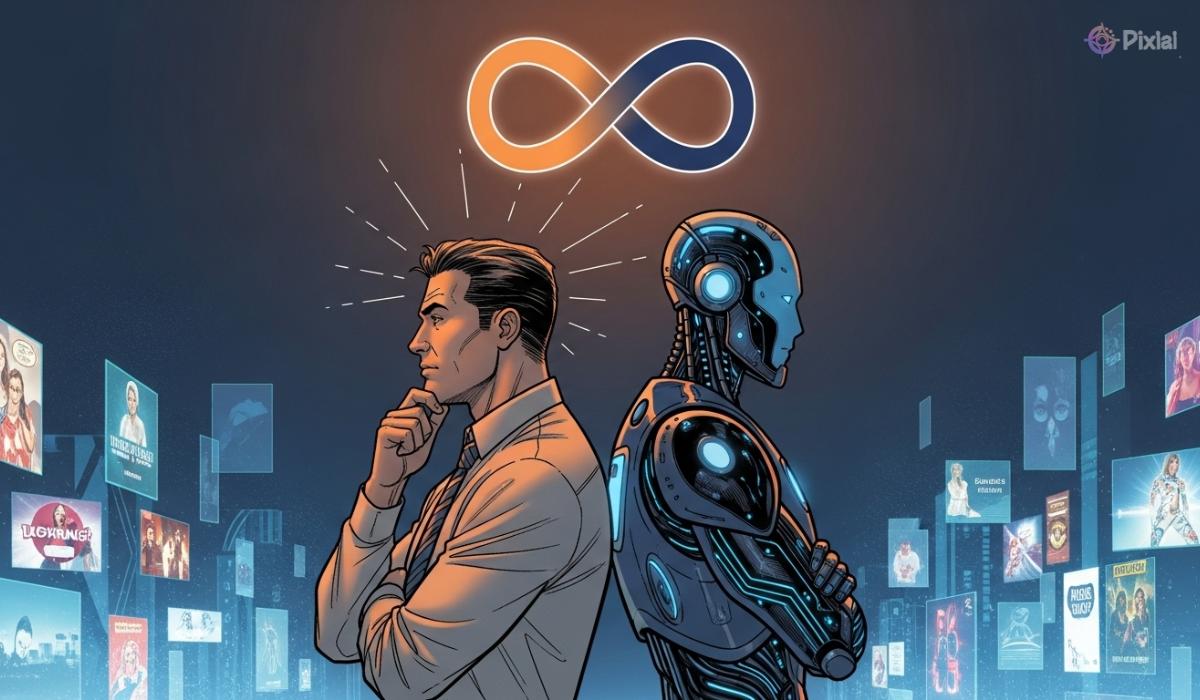
Successful collaboration begins with clearly defining roles and appreciating the unique strengths each partner brings to the table.
One provides the engine, and the other provides the soul.
What AI Does Best: The Power of Data and Scale
AI’s strength lies in its ability to process information at a scale no human team ever could. Its core competencies in advertising are purely analytical and executional:
- Data-Driven Insights: AI can analyze thousands of competitor ads, market trends, and performance metrics to identify patterns and opportunities that humans would miss.
- Hyper-Personalization: It can segment audiences into micro-cohorts and tailor ad components (visuals, copy, CTAs) to each one, delivering a level of relevance that was previously impossible.
- A/B Testing Automation: AI can create and test hundreds of ad variations simultaneously, rapidly identifying winning combinations and optimizing campaigns in real-time.
- Predictive Analytics: By analyzing historical data, AI can forecast campaign performance, predict customer churn, and identify high-value audience segments before a single dollar is spent.
The Irreplaceable Role of Human Creativity: The Power of Soul
While AI manages the what and where, humans control the why. Human creativity provides the soul of the campaign, an element that data alone cannot generate. These uniquely human contributions include:
- Emotional Storytelling: Crafting a narrative that resonates with human experience—joy, humor, ambition, nostalgia—is what builds brand affinity.
- Brand Tone and Nuance: A machine can mimic a brand’s voice, but only a human can truly understand and evolve it, ensuring it feels authentic and culturally relevant.
- Strategic Vision: Defining the core message, the long-term brand objective, and the big, disruptive creative idea is a task for a strategist, not an algorithm.
- Ethical Oversight: Humans are the essential guardians who ensure that ads are not just effective but also responsible, inclusive, and aligned with brand values.
The Gap: Why a Hybrid Model Always Wins
Relying only on AI leads to soulless, generic ads that may perform well on short-term metrics but fail to build lasting brand equity. They often lack a cohesive story and can feel uncanny or off-brand.
Conversely, relying only on human creativity is slow, expensive, and unscalable. It leads to missed opportunities for personalization and optimization, ultimately leaving performance on the table.
The hybrid model bridges this gap.
A 2025 consumer sentiment report is telling: 48% of consumers trust ads co-created by a human with AI support, compared to a mere 13% who trust ads created entirely by AI.
The conclusion is inescapable. Consumers want the relevance AI provides, but they need the authenticity that only a human touch can guarantee.
Proven Strategies to Combine AI and Human Creativity for Better Ad Results
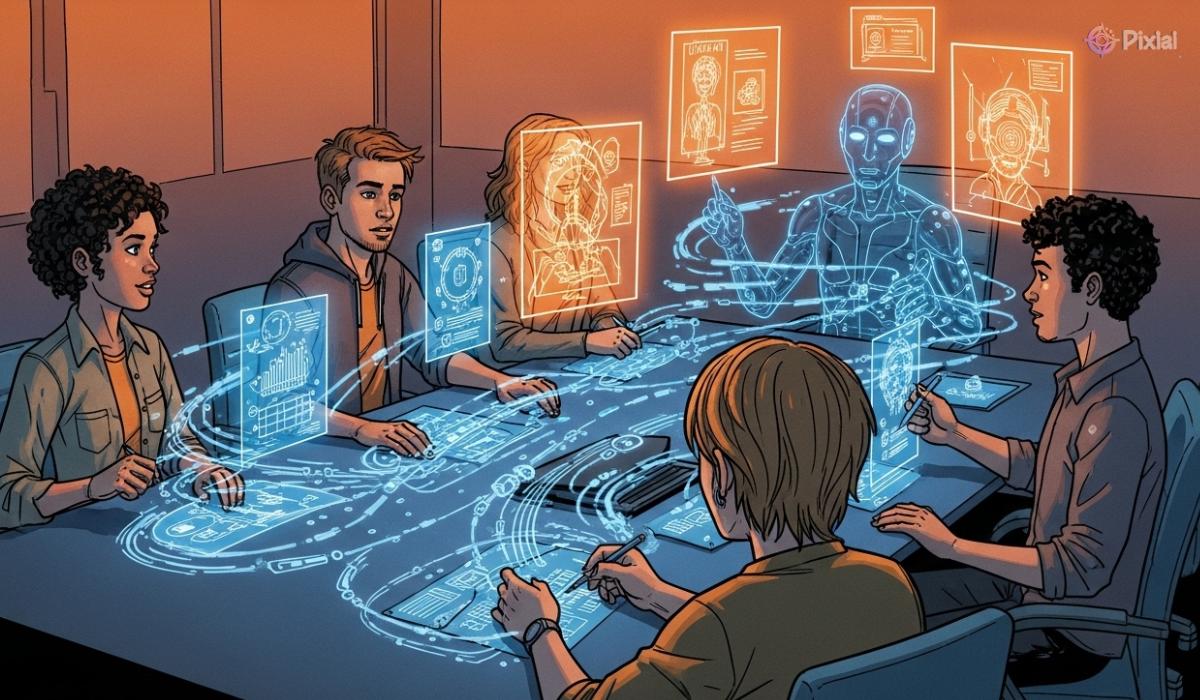
Theory is one thing, but practical application is what drives results. Here are three actionable strategies that leading brands are using to turn the human-AI partnership into measurable performance gains.
Strategy 1: Use AI for Data Analysis, Humans for Message Direction
This is the foundational hybrid strategy. Let AI platforms analyze your audience’s behavior, media consumption habits, and past conversion data.
The AI’s job is to deliver a detailed brief: who to target, what topics they care about, and which channels they use.
And the human creative director then takes this data-rich brief and crafts the core message—the emotional, compelling story that will resonate with that specific audience.
Strategy 2: Let AI Handle Repetitive Tasks, While Humans Innovate
Free your best creative minds from drudgery. Use AI to automate budget allocation, bid management, and the generation of basic ad variations for testing.
This frees up human creatives to focus their energy on developing the “big idea.”
While the machine is busy optimizing the campaign mechanics, the human team can be storyboarding the next breakthrough TV spot or designing an immersive brand experience.
Strategy 3: Co-Create Ad Visuals and Copy with AI Tools
This is where the collaboration becomes truly dynamic. Use generative AI tools as a brainstorming partner.
An art director can use the Pixi AI Art Generator to create dozens of visual concepts in minutes.
A human designer then selects the best concepts and uses their expertise to refine, retouch, and perfect the final asset, ensuring it meets brand standards.
Similarly, a copywriter can use AI to generate headline variations or initial drafts. Then infuse them with brand voice, humor, and persuasive flair.
This workflow, incorporating tools like our AI Graphics Design and AI Video Generator, dramatically accelerates the creative process without sacrificing quality.
Real-World Examples: How Brands Win with AI + Human Collaboration
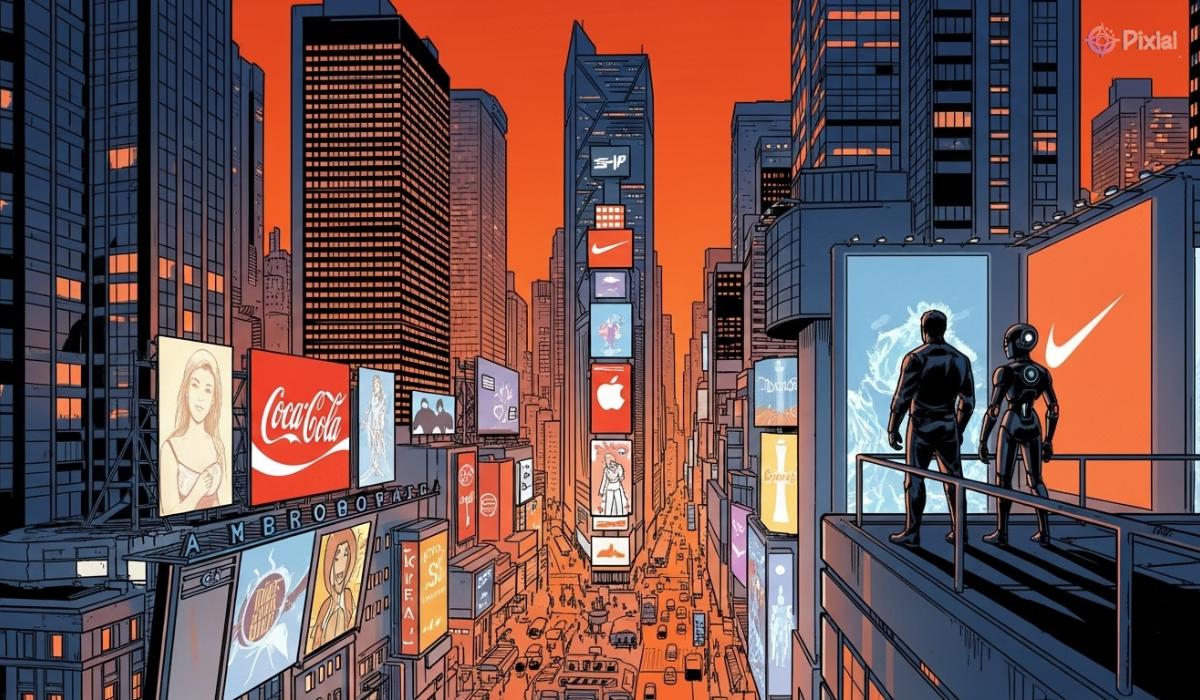
From global beverage giants to nimble e-commerce startups: this hybrid model works across all scales.
Let’s examine how top-tier brands are putting these strategies into practice to achieve remarkable outcomes.
Case Study: Coca-Cola’s “Create Real Magic” AI Campaign
Coca-Cola brilliantly demonstrated the power of human-guided, AI-powered co-creation.
They didn’t just use AI to make their own ads; they invited consumers to create ads with them.
Using a platform powered by DALL·E and GPT-4, they allowed fans to generate original artwork using iconic brand assets like the contour bottle and polar bears.
Human art directors curated the best submissions, which were then featured on massive digital billboards in Times Square.
The strategy was genius: AI provided the accessible tool, but the human-led brand framework and curation ensured the results were magical, not chaotic.
Case Study: Nike’s AI-Powered Personalization Strategy
Nike’s brand is built on a deeply human story of athletic achievement. They use AI to make their story profoundly personal for every customer.
Their app uses AI to analyze user data and provide personalized workout plans, product recommendations, and content.
The ads they deliver are informed by this AI-driven data, but the creative itself—the powerful imagery, the inspirational copy, the signature “Just Do It” ethos—is pure human storytelling.
The Small Business Blueprint
This strategy isn’t just for giants. Imagine a small e-commerce brand. The owner can use ChatGPT to brainstorm ad angles based on their target audience’s pain points.
They can then use the Pixi AI Video Generator to create multiple video ads showcasing their product, using AI to handle the editing and animation.
For guidance on scripting, they can even consult resources on how to write the perfect script for AI video generation.
Finally, the owner provides the voiceover and makes the final edits, ensuring the ad reflects their authentic brand voice.
This is a prime example of how small businesses can create videos using AI to compete on a larger scale.
Tools and Frameworks to Implement AI + Human Collaboration in Ads
Adopting a new methodology requires both the right technology and a clear process. This section provides a starter toolkit and a structured workflow to help you integrate human-AI collaboration into your team’s daily operations.
The Modern Advertiser’s AI Toolkit
Building a hybrid workflow requires the right tools. Your stack should include:
- Generative AI for Ideation: ChatGPT, Jasper, and Copy.ai for copy; Midjourney and DALL·E for image concepts.
- Ad Creative Platforms: AdCreative.ai, Canva Magic Studio.
- All-in-One Creative Suites: The Pixi AI Marketing Tools suite is designed to facilitate this entire workflow, from its powerful AI Art Generator to one of the best AI video generator tools available.
The Hybrid Creative Workflow Model
Implement a structured, 5-step framework to integrate AI into your process seamlessly:
- Analyze with AI: Use AI tools to gather audience insights, analyze competitor strategies, and identify market trends.
- Ideate with AI: Use generative AI as a brainstorming partner to rapidly explore creative concepts, copy angles, and visual styles.
- Create with AI & Humans: AI generates the initial assets and variations. Human creatives then refine, curate, and elevate the final product to meet brand standards.
- Optimize with AI: Deploy the ads and let AI platforms manage real-time bidding, budget allocation, and A/B testing to maximize performance.
- Scale with AI: Once winning combinations are identified, use AI to scale the campaign, personalizing creative for new audience segments across multiple channels.
How to Train Your Team to Use AI Effectively
Technology is only as good as the people using it. Overcoming the skills gap is crucial. Invest in your team by:
- Hosting Internal Skill Sessions: Dedicate time for hands-on training with new AI tools.
- Creating a Prompt Library: Develop a shared resource of effective prompts for generating on-brand copy and visuals.
- Establishing Human-Led Review Cycles: Implement a clear process where all AI-generated content receives a final review from a human brand steward before going live.
The Future of Advertising: Human Emotion Enhanced by Artificial Intelligence
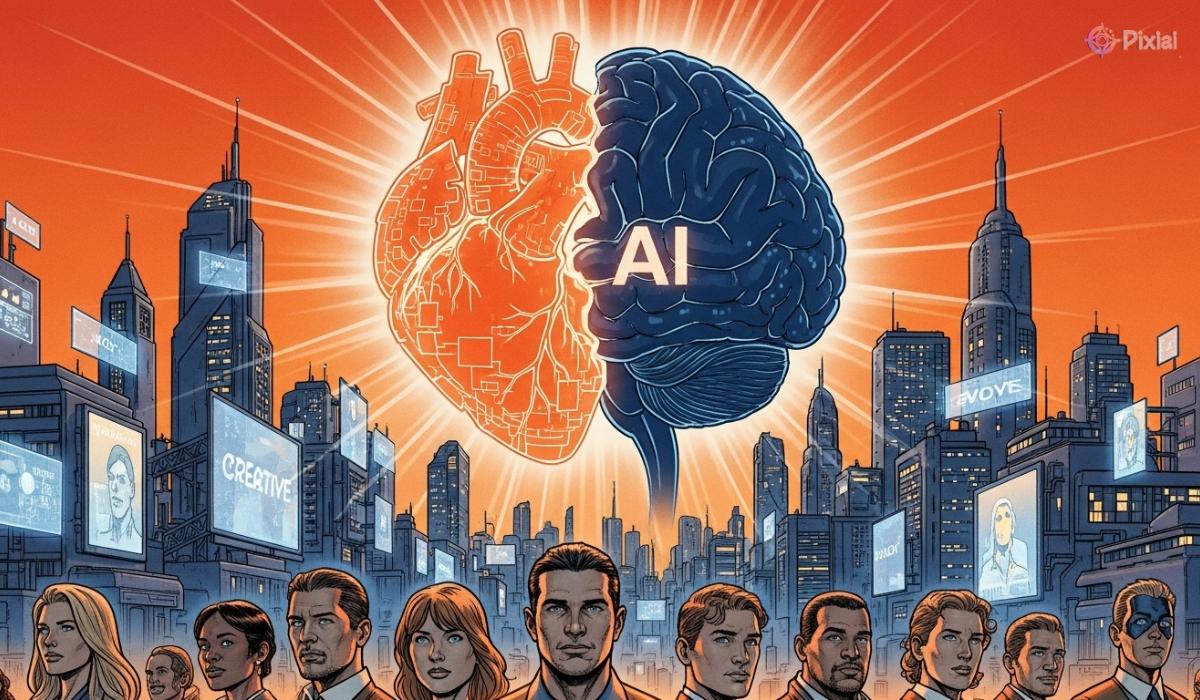
As powerful as this partnership is today, we are only scratching the surface of what’s possible.
Looking ahead, the synergy between human insight and machine intelligence is set to unlock even more sophisticated and effective advertising innovations.
Predicting the Next Wave of Ad Innovation
The collaboration is just beginning. The next wave of innovation will see AI capabilities become even more integrated into the creative process.
Look for the rise of AI-driven emotional recognition that can analyze sentiment in user comments to inform creative tone.
Expect real-time ad personalization to reach a new level, where a video ad’s narrative could shift mid-stream based on a viewer’s engagement signals.
Predictive creative testing will become standard, with AI forecasting an ad’s success before it’s even produced.
Why Brands That Blend AI and Creativity Will Dominate
The brands that dominate the next decade will be those that master the Human+AI partnership.
They’ll merge the emotional intelligence and strategic vision of humans with the analytical power and speed of machines.
The result? A trifecta of advertising excellence — stronger brand recall, lower customer acquisition costs, and significantly higher ROAS.
They will create ads that are ruthlessly effective and also genuinely loved.
Your Action Plan for Q4 2025
Don’t wait for the future to happen to you. Start building it now with this simple 3-step plan:
- Audit Your Current Ad Process: Identify the bottlenecks and repetitive tasks that could be automated.
- Integrate 2–3 AI Tools: Start small. Introduce a generative AI tool for brainstorming and an optimization platform for one of your core channels.
- Track Performance Improvements: Measure the impact on key metrics like ROAS, CTR, and creative production time.
Conclusion: Your Creative Co-Pilot Awaits
The most formidable force in the future of advertising will not be an algorithm or a lone creative genius.
It will be a brilliant, strategic human mind amplified by the speed, data, and infinite generative power of a machine.
Stop viewing AI as a threat and start treating it as your indispensable creative co-pilot. Let it handle the calculations while you craft the concepts.
Let it generate the variations while you perfect the vision. The brands of tomorrow are being built today by teams that master this collaboration.
The brands of tomorrow are being built today by teams that master this collaboration.
Start integrating powerful, AI-driven creative strategies with the Pixi AI Marketing Tools suite and turn your human ideas into superhuman results.
